Washing Rules
When sanitizing dirty items, follow these tips:
- Wash dishes no later than 2 hours after use. In this case, food residues do not have time to dry and are easily removed from the surface of the devices.
- Wash dirty dishes in several waters, which allows you to get rid of small dirt. It is desirable to have a 2- or 3-section sink in the kitchen. But if you do not have one, you can wash the inventory in a basin and rinse under running water. It should be borne in mind that glassware and cutlery (spoons, forks, knives) undergo 2-stage cleaning, and other dishes – 3-stage. Therefore, before starting the process, you should prepare the necessary containers.
- Use household detergents. If you wash dishes with clean water, small dirt and greasy deposits will remain on the surfaces. Specialized household chemicals help soften and remove stains.
- Use clean water, the temperature of which is at least +45°C. In this case, chemicals dissolve faster and form abundant foam, which allows you to effectively wash dishes from all types of dirt.
- Rinse with cool water. In this case, no soapy residue remains on the surface of the dishes. However, the water should not be too cold, so that the condition of the skin of your hands does not worsen.
- Dry the cutlery well. In this case, stains will not form on the washed surface, and dampness will not accumulate in the cabinet, which contributes to the formation of mold and damage to furniture. Therefore, plates and cutlery should be dried especially carefully. It is not necessary to use special dryers, you can leave the dishes on the table until they dry completely or wipe them with a clean dry towel (paper or cloth).
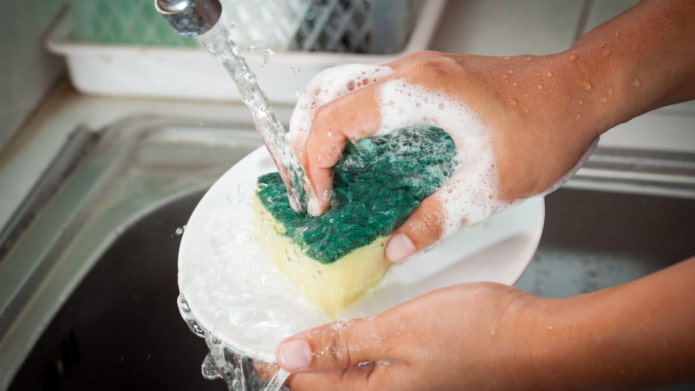
Necessary set of materials and tools
When washing dishes, you should use special tools and materials that help to clean surfaces more effectively. As a rule, they are always at home.
A standard set of tools and materials for sanitizing cutlery and utensils includes:
- dishwashing detergent (liquid or powder);
- 2- or 3-section sink (can be replaced with pots or basins);
- hot and cool water poured into different compartments;
- sponge (foam or metal).
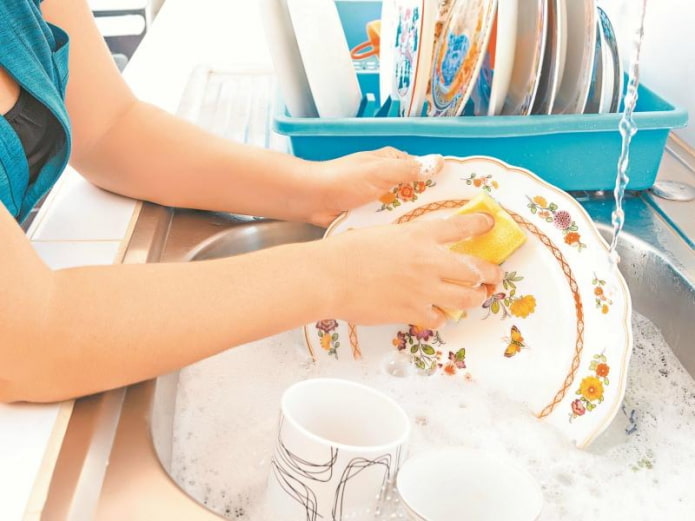
At the drying stage, you will need:
- clean paper napkins;
- clean towel made of fabric (cotton or linen);
- soft sponges.
You should also prepare gloves to protect your hands from exposure to chemicals.
Washing Features for Different Materials
Although general recommendations for washing dishes have been developed, the technology may differ depending on the material from which the utensils are made.
Special rules have been developed for washing the following types of utensils:
- Enameled (as well as cast iron, aluminum, iron). Wash utensils made of this material in hot clean water using a mild detergent. When processing aluminum products (pots, frying pans), do not use a metal sponge, hard brushes, alkaline powders to prevent scratches and oxidation of the surface.
- Made of glass and porcelain. Such devices are cleaned with cool water with a small amount of a mixture of salt and table vinegar in equal proportions. It is enough to dissolve 0.5 tbsp. of the product in a liquid of 8-10 liters. This composition helps to quickly and easily wash away small dirt and prevent the appearance of a cloudy film on the glass after drying.
- Crystal. Products made of this fragile transparent material are washed in warm clean water, after which they are rinsed with a weakly concentrated solution with baking soda. This helps to wash away stains, get rid of streaks and give the product a natural shine.
- Clay. The material easily absorbs chemicals and odors, so it should not be treated with detergents. Washing is carried out using clean warm water.
- Ceramic (clay with a glazed coating). Treated with a hot soapy solution using a sponge. In addition, ceramic dishes are usually rinsed with cool water and baking soda.
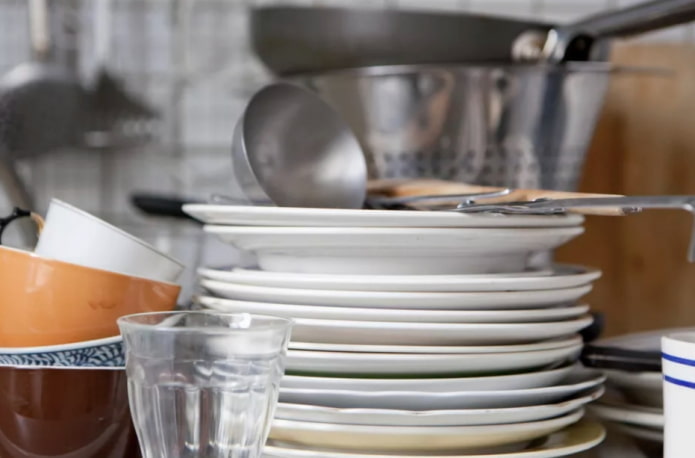
Frying pans, small plates and cutlery are washed according to the same rules. In this case, the sponge can be replaced with a medium-hard or soft toothbrush. This advice should not be neglected. Unlike a sponge, such a useful tool as a brush allows you to remove even the smallest dirt and grease in hard-to-reach places and on the edges.
Step-by-step instructions
When sanitizing products at home, it is important to adhere to the sequence of steps. The correct way to wash dishes is as follows:
- Remove large food residues. To avoid getting your hands dirty, use paper napkins or rubber gloves. If the food residue has dried and cannot be cleaned off, pre-soak the dishes: add a small amount of soda (or detergent), fill with hot water and leave for 20-30 minutes. During this time, large stains will soften and come off easily.
- Soak the dishes in a sink compartment or basin filled with clean hot water and leave for a few minutes. In this case, add a small amount of detergent to the liquid, and when preparing the solution, strictly adhere to the manufacturer’s recommendations regarding the dosage indicated on the bottle label.
- Wash. First of all, lightly soiled dishes are processed: usually these are cutlery (spoons, forks, knives), mugs, cups, glasses. Gradually begin to wash the food residue off the plates and serving utensils, then the pots and pans. In the process, the dishes are held under water and periodically taken out to notice uncleaned areas. Be sure to treat all surfaces: internal and external. Especially carefully clean the food residue off the plates and mugs in the corners. If the solution has stopped foaming or has become very dirty, then drain it and mix a new one.
- Rinse the dishes with clean hot (or cool) water. Dip them in a pre-filled basin, sink, or rinse with a stream of running water from the tap. All utensils are carefully treated, carefully ensuring that there are no stains or soap film left on the washed surfaces.
- Dry. Leave on the table to dry naturally. Frying pans and pots that may have traces of grease on them are wiped with clean paper or cloth towels.
- Put clean plates, cups and other utensils (spoons, forks, knives) in the cupboard.
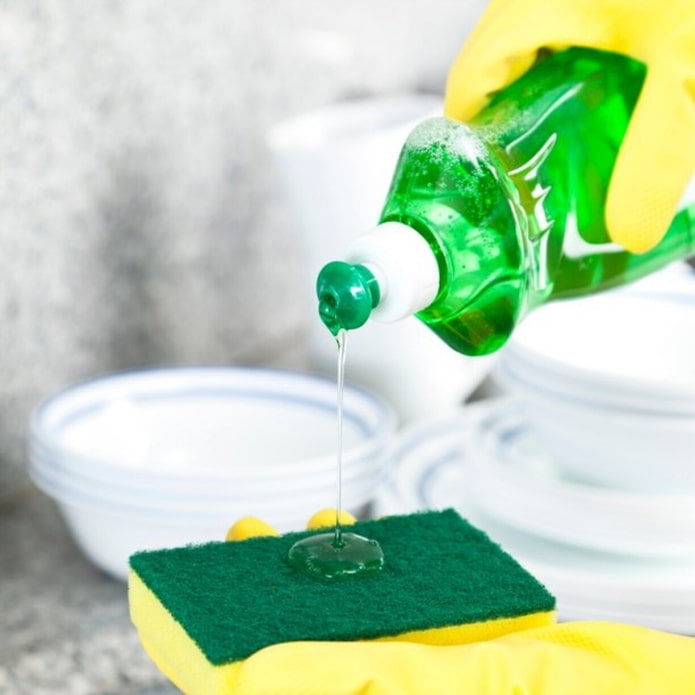
After completing the procedure, you should clean: wash off dirt (food residue and grease) from the surface of the sink, rinse with water and soda and dry. The sponge and rag should be soaked, thoroughly washed from stains and hung up. It is not difficult and takes only a few minutes.
Tips for combating difficult stains
The most persistent stains do not remain on plates and cups, but on the bottom of the pot or frying pan, where burnt food and fat remain. To eliminate them, it is recommended to follow useful tips:
- Place the pot or frying pan on a lit burner and after a while pour a small amount (about 20% of the total volume) of water inside. After a few minutes, the steam will dissipate, then you can begin intensively removing dirty stains using a wooden spatula, and then a hard (if the material is not prone to scratching) sponge.
- Fill the pot or frying pan with water with a small amount of detergent added and place it on a lit burner. Bring to a boil and continue heating for 5-15 minutes. Leave until the liquid temperature cools to room temperature and start mechanical cleaning using a foam sponge and soap solution (sometimes with soda). Carbon deposits and grease should come off easily.
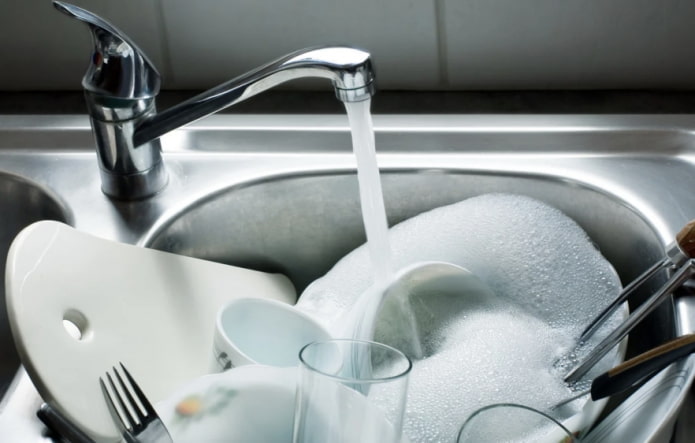
If you wash pots and pans according to these recommendations, you can easily and quickly deal with difficult stains (burnt food residues). You just need to protect the skin of your hands so that it remains beautiful and healthy.
Now reading:
- Living room design ideas 20 sq. m: layouts and 63 photos of interiors
- Kitchen-living room design 12 m²: 45 photos and ideas with a sofa.
- Wrought Iron Tables: Over 60 Interior Photos and Stylish Design Ideas
- Wine Cork Craft Ideas: 44 Creative Projects with Photos and Videos
- Living room in white: 55 photos and modern design solutions.